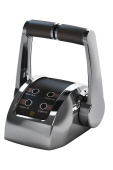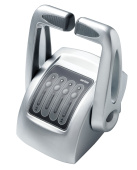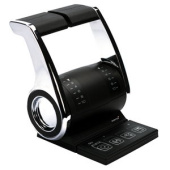Electronic boat throttle controls represent a cutting-edge advancement in marine technology, providing boaters with precise and responsive control over their boat's propulsion systems. These state-of-the-art controls offer a host of features that enhance your boating experience, making navigation easier and more enjoyable.
|
1-2 weeks delivery time Price incl. 19% VAT The handle and housing of the Vetus EC4 Electric Lever Control are crafted from high-quality stainless steel (AISI 316). This engine control unit is suitable for both motor and sailboats. The system can manage one or two engines and can be installed on multiple stations, each with identical control functions. Communication between stations and remote control is facilitated through the CAN-bus protocol. The EC4 system is easy to install and complies with EMC requirements for electromagnetic compatibility.
|
€ 1.430,47
Type:
Item:
| |||
|
1-2 weeks delivery time Price incl. 19% VAT The EC3 model, a predecessor to the EC4, is a Vetus unit designed for electronic engine control, enclosed in a fully waterproof polished stainless steel case. It is compatible with 12/24V electrical systems and is suitable for use with fully electronically controlled engines, offering combined mechanical and electronic control capabilities. Additionally, it can be used with hydraulic gearboxes and swivel columns, making it a versatile choice for one or two engines. Various models are available to meet your specific needs.
|
Type:
Item:
| |||
|
1-2 weeks delivery time Price incl. 19% VAT VETUS RECO electronic engine controls developed by Rexroth have a proven track record of being extremely reliable and popular over the years. Now, building on customer experience and evolving technology, VETUS introduces the next generation of electronic engine controls: the ECS (Electronic Control System).
|
Type:
| |||
What is the primary function of electronic throttle controls in a boat's engine control system?
The primary function of electronic throttle controls in a boat's engine control system is to provide precise and smooth management of engine power and propulsion. Using a control head, the system integrates with both single and dual engine setups, allowing operators to manage acceleration and deceleration efficiently. The system often includes smart actuators and microprocessors to ensure seamless operation across various stations, with optional backup systems for added reliability.
How does an electronic engine control system improve precision compared to a mechanical control system?
An electronic engine control system improves precision by delivering more accurate and responsive control over the marine engine compared to a mechanical system. It eliminates the need for physical cables and instead uses advanced propulsion controls to manage throttle and shift electronically, ensuring smoother operation. Whether controlling a single engine or multiple stations, the system offers enhanced responsiveness, making it ideal for precise maneuvers like trolling or handling inboard setups.
What role does the control head play in an electronic control system for single and dual engine configurations?
The control head in an electronic control system plays a crucial role in managing throttle and shift functions for both single and dual engine configurations. It acts as the interface between the operator and the marine electronic engine controls, allowing precise control over engine performance. Whether part of a single station or up to 4 stations, the control head ensures smooth operation by sending commands through wires to the engine, making it a key component in the complete control system.



